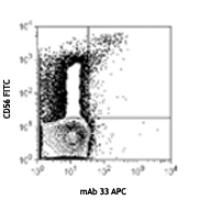-
Sign In
-

-
 Sony Biotechnology
Sony Biotechnology
-

-
 Sony Biotechnology
Sony Biotechnology
APC anti-human CD158d (KIR2DL4)
Antibodies Single
Sony
mAb 33 (33)
Flow Cytometry
Mouse IgG1, κ
Human
NK3.3 cells and KIR2DL4-Ig fusion protein
2335040
$352.00
Description
CD158 molecules, also known as KIRs (killer cell immunoglobulin-like receptors), are a family of transmembrane proteins with either two (KIR2D) or three (KIR3D) Ig-like extracellular domains. Some KIRs, with long cytoplasmic domains, contain ITIMs and possess inhibitory functions and others, with short cytoplasmic regions, lack ITIM and have activation functions. Fourteen polymorphic KIR genes have been reported in humans. KIR2DL4 (CD158d) is a unique receptor which has an ITIM in its cytoplasmic domain and a charged residue in the transmembrane domain. It possesses both inhibitory and activation functions. Two common alleles (10A and 9A) of KIR2DL4 have been reported. The 10A allele (with 10 adenines at the end of the transmembrane exon) receptor is expressed on CD56high NK subset, whereas its expression on CD56dim NK cells is inducible upon culture. The major 9A allele receptor is a secreted form. HLA-G is the ligand of CD158d.
Formulation
Phosphate-buffered solution, pH 7.2, containing 0.09% sodium azide and 0.2% (w/v) BSA (origin USA).Recommended Usage
Each lot of this antibody is quality control tested by immunofluorescent staining with flow cytometric analysis. Test size products are transitioning from 20 microL to 5 microL per test. Please check your vial or your CoA to find the suggested use of this reagent per million cells in 100 microL staining volume or per 100 microL of whole blood. It is recommended that the reagent be titrated for optimal performance for each application.
References
1. Rajagopalan S, et al. 2001. J. Immunol. 167:1877. (FC)
2. Goodridge JP, et al. 2003. J. Immunol. 171:1768. (FC)
3. Rajagopalan S, et al. 2006. PLoS Biol. 4:e9.


